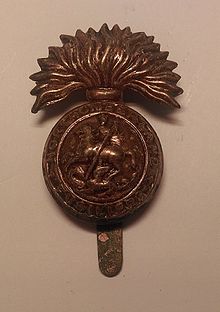Northumberland Fusiliers
| 5th (Northumberland) Regiment of Foot Northumberland Fusiliers Royal Northumberland Fusiliers |
|
|---|---|

Cap badge of the Northumberland Fusiliers.
|
|
| Active | 1674–1968 |
| Country |
|
| Branch |
|
| Type | Line infantry |
| Role | Fusiliers |
| Size |
First World War: 52 battalions Second World War: 10 battalions |
| Garrison/HQ | Fenham Barracks, Newcastle upon Tyne |
| Nickname(s) | The Fighting 5th , 5th of Foot |
| Motto(s) | Quo Fata Vocant (Whither the Fates call) |
| Colors | Gosling green facings |
| Anniversaries | St Georges Day 23 April |
| Commanders | |
| Notable commanders |
Robert Leith-Macgregor (1st Battalion, 1960–62) |
| Insignia | |
| Hackle | Red over White |
The Royal Northumberland Fusiliers was an infantry regiment of the British Army. Originally raised in 1674 as the 5th Regiment of Foot, it was given the regional designation 'Northumberland' in 1782 and granted the distinction of being a Fusilier regiment in 1836, becoming 5th (Northumberland Fusiliers) Regiment of Foot. The regiment adopted the title Northumberland Fusiliers when regimental numbers were abolished under the Childers Reforms of 1881 and became the Royal Northumberland Fusiliers on 3 June 1935.
In 1968, the Royal Northumberland Fusiliers, after service in many ways, including both World War I and World War II, were amalgamated with the other regiments in the Fusilier Brigade–the Royal Fusiliers (City of London Regiment), the Royal Warwickshire Fusiliers and the Lancashire Fusiliers–to form the present Royal Regiment of Fusiliers.
The regiment was originally part of the Dutch service and known as the Irish Regiment, or Viscount Clare's Regiment, under the command of Daniel O'Brien, 3rd Viscount Clare. In the following year the colonelcy passed to John Fenwick and the "Irish" designation was discontinued and the regiment was referred to as a "Holland Regiment". The regiment was transferred to the British Service on 5 June 1685, establishing its order of precedence as the 5th Regiment of the Line. Like most other regiments, it was known by the names of the colonels who successively commanded it at the time until it became the 5th Regiment of Foot in 1751.
The regiment took part in the Irish campaign of 1690–1691, and was present at the Battle of the Boyne, the Second Siege of Athlone and the 1691 Siege of Limerick. In 1692 the unit sailed for Flanders where they were to remain for five years. In 1695 they were part of the allied forces that recaptured Namur. With the ending of the war by the Treaty of Ryswick they returned to England in 1697.
...
Wikipedia
